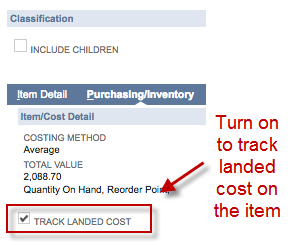This article is relevant if you do not have NetSuite’s Assembly item feature and you are seeking to capitalize (add) packaging based costs to the purchase price of finished goods.
Background
 A client who manufactures in China and distributes goods worldwide recently discovered that they could lower their packaging costs by sourcing their materials from another supplier. Previously, their product supplier gathered all raw materials, including packaging material, and produced the final finished good for delivery and distribution. In the new model to save money, the client independently gathers packaging materials and has them delivered to their main product supplier as needed.
A client who manufactures in China and distributes goods worldwide recently discovered that they could lower their packaging costs by sourcing their materials from another supplier. Previously, their product supplier gathered all raw materials, including packaging material, and produced the final finished good for delivery and distribution. In the new model to save money, the client independently gathers packaging materials and has them delivered to their main product supplier as needed.
The client sought advice on how to move the packaging materials costs into the product cost to ensure that item margins were properly accounted for.
General Pattern for Capitalizing Non-Purchased based Costs Into Inventory
The key to understanding this practice is to leverage NetSuite’s Landed Cost feature. In particular, in a previous article, Offer: Superior NetSuite Landed Cost Practice with Late Vendor Bills, I discuss a method that leverages Landed Cost in a manner that streamlines the accounting process. It is in this method that a world opens for pushing in extra costs into inventory.
The key to this it consider the following:
- Primary Finished Good Purchase Order: this is the purchase order that represents the item that will become finished goods inventory. Here, use the traditional purchase order price from the supplier without respect for add-in costs coming from other inputs. Keep it simple.
- Additional Costs Purchase Orders: in the case of packaging, most of my clients do not want to maintain a stock ledger. Due to this, it makes this practice easier. Here, we will have a Non-Inventory based item that will be used to for purchase order, item receipt and vendor bill processes.
The Capitalize Packaging Cost Practice
- Acquire Non-Inventory Packaging Costs: use NetSuite’s standard Purchase Order, Item Receipt and Vendor Bill practices to acquire packaging materials. Be sure that the item account definition points to your balance sheet account. In general, the net effect of this flow is to debit Packaging Materials (an asset) and to credit Accounts Payable.
- Purchase Order for Finished Goods: as discussed above, use a standard purchase order for the goods you acquire. This practice may be easier to understand if there is only one product (thus one line item) per purchase order. But it does not have to go that way.
- Purchase Order Item Receipt: when the good are received, you are going to use the Landed Cost feature to push cost into the item. Here, if you use the practice suggested in the previous article, you will need to know how much cost to apply on to the items being received. In general, this often is known in terms of quantity. For example, each item should get $.50 of packaging cost. Thus, if there are 1,000 items on the receipt, you will push in $500.00.
- Landed Cost Application: Using NetSuite’s landed cost feature, determine the total value of the packaging costs to apply. If you have many different items on your item receipts, then use the Landed Cost per Item feature. When the item receipt is saved, the inventory costs will be increased and the Package Materials balance sheet account will be decreased. In accounting terms, debit Inventory and credit Packaging Materials.

- Periodic Packaging Costs Review: on a periodic basis, assess the reasonableness of the value of the Packaging Materials asset account. The amount should approximate the value of the packaging materials that have not yet been used in finished goods production. If it is not reasonable, there is a breakdown in the practice to investigate.
The Setup Required
- Activate Landed Cost Feature: The Landed Cost feature is available if you have Advanced Shipping/Receiving. The feature is available under Setup, Company, Enable Features, Items / Transactions.

- Landed Cost Category: setup a “Packaging” landed cost category at Setup, Accounting, Accounting Lists, New Cost Category. Be sure to point the general ledger account to your Packaging Materials asset account previously created (not shown).
- Packaging Materials Non-Inventory Items: create non inventory items for Packaging Materials and point the general ledger account to the Packaging Materials asset account.
- Turn on Inventory Item Track Landed Costs: for each item that needs to have landed costs, under the item’s purchasing tab, turn on the “Track Landed Cost” switch.


















